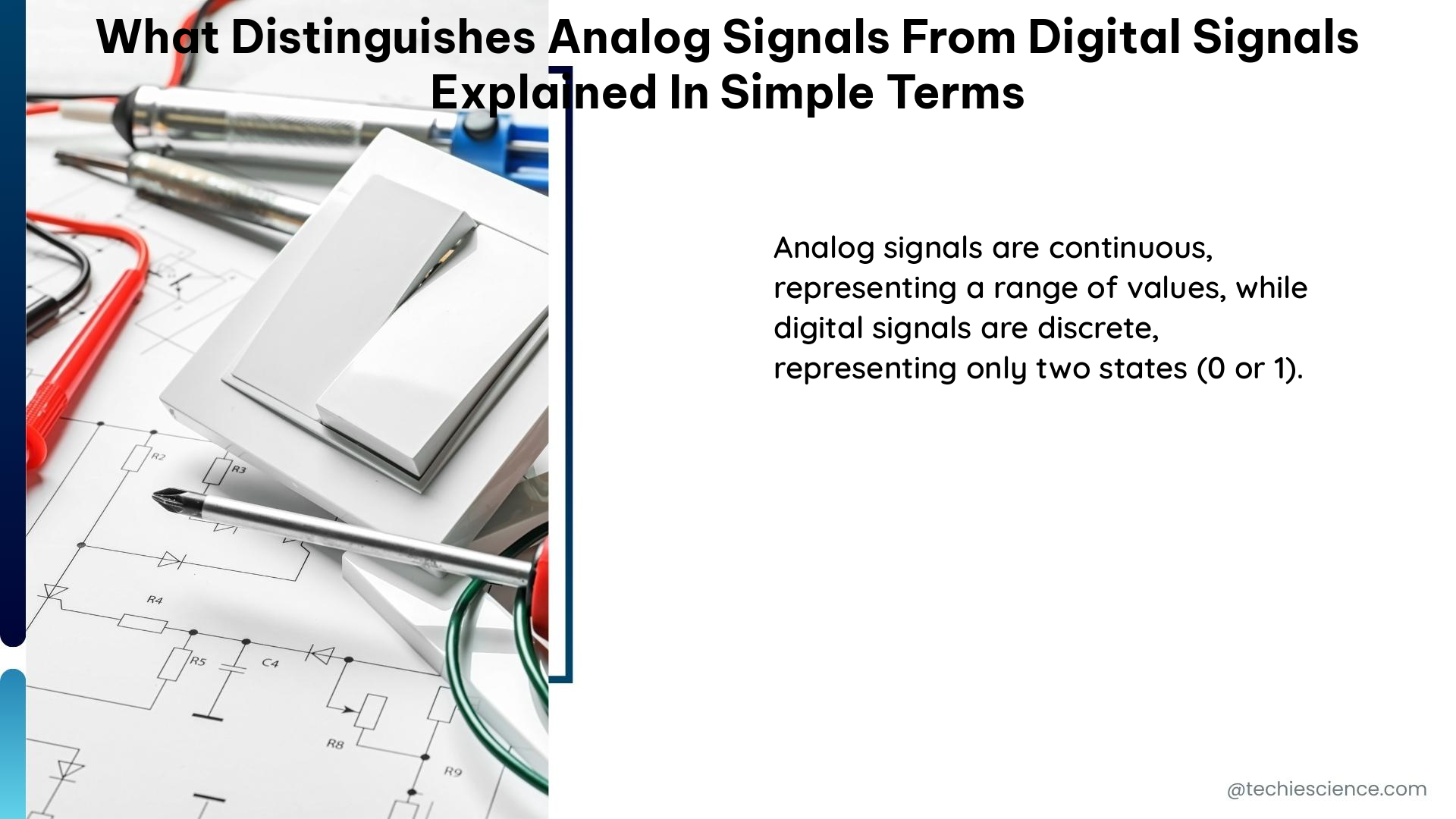Analog signals are continuous in nature, capable of taking on an infinite number of values, while digital signals are discrete, restricted to a finite set of values. This fundamental difference has far-reaching implications in various aspects of signal processing and transmission.
Continuity vs. Discreteness
Analog signals are characterized by their continuous nature in both amplitude and time. This means that the signal can change smoothly and gradually, without any abrupt jumps or steps. In contrast, digital signals are discrete, meaning they can only take on specific, predefined values at fixed time intervals.
For example, an analog audio signal representing a musical note can vary its amplitude continuously, capturing the nuances and dynamics of the sound. On the other hand, a digital audio signal would represent the same note by sampling the amplitude at regular intervals, resulting in a series of discrete values.
Bandwidth and Frequency Range

Analog signals typically have a lower bandwidth requirement compared to digital signals. This is because analog signals only need to transmit the continuous range of values, while digital signals must transmit the discrete set of values, which requires a wider frequency range.
The bandwidth of an analog signal is determined by the highest frequency component present in the signal. For instance, the human voice has a bandwidth of approximately 3 kHz, which is sufficient to transmit the continuous range of frequencies that make up speech.
Digital signals, on the other hand, require a wider frequency range to accurately represent the discrete values. The higher the number of discrete levels, the wider the frequency range needed. This is why digital audio and video signals often have much higher bandwidth requirements than their analog counterparts.
Noise Immunity and Error Correction
Digital signals are generally more immune to noise and distortion than analog signals. This is because digital signals can be encoded with error correction techniques, such as parity bits or cyclic redundancy checks (CRC), which allow the receiver to detect and correct errors in the transmitted data.
Analog signals, however, are more susceptible to noise and distortion, which can degrade the quality of the signal and introduce errors. This is because any interference or distortion in the analog signal can directly affect the continuous range of values, making it difficult to accurately reconstruct the original signal.
Power Consumption
Analog signals typically consume more power than digital signals. This is because analog signals require a continuous flow of electricity to maintain their signal strength, whereas digital signals only need to maintain their discrete values, which can be done with lower power requirements.
For example, in battery-powered devices, the use of digital signals can significantly extend the battery life compared to the use of analog signals. This is why many modern electronic devices, such as smartphones and laptops, rely heavily on digital signal processing to optimize power consumption.
Signal Processing and Circuit Design
Analog signals are processed using analog circuits, which typically consist of resistors, capacitors, inductors, and other passive components. These analog circuits are designed to manipulate the continuous range of values in the analog signal, such as amplifying, filtering, or modulating the signal.
Digital signals, on the other hand, are processed using digital circuits, which typically consist of transistors, gates, and other active components. These digital circuits are designed to manipulate the discrete values in the digital signal, such as performing logical operations, arithmetic calculations, or data storage and retrieval.
The design and implementation of analog and digital circuits differ significantly, with analog circuits often requiring more complex and specialized components, while digital circuits can leverage the power of digital logic and integrated circuits.
Practical Applications and Considerations
The choice between analog and digital signals depends on the specific requirements of the application. Analog signals are often used in applications where continuous, high-fidelity signal representation is essential, such as in audio and video systems, sensor measurements, and control systems.
Digital signals, on the other hand, are widely used in modern communication systems, data storage, and digital signal processing applications, where the advantages of noise immunity, error correction, and efficient signal processing outweigh the potential loss of signal fidelity.
In many cases, hybrid systems that combine both analog and digital components are used, leveraging the strengths of each approach to achieve the desired performance and functionality.
Conclusion
The fundamental differences between analog and digital signals, as outlined in this article, have a profound impact on the design, implementation, and performance of various electronic systems and applications. Understanding these distinctions is crucial for engineers, scientists, and technicians working in the field of signal processing and communication.
By exploring the continuity vs. discreteness, bandwidth and frequency range, noise immunity and error correction, power consumption, and signal processing aspects, this article provides a comprehensive and technical guide to the distinguishing characteristics of analog and digital signals. This knowledge can be invaluable in making informed decisions, designing efficient systems, and troubleshooting complex electronic devices.
References:
- Analog vs. Digital Signals: Uses, Advantages and Disadvantages
- Difference between Analog and Digital Signal – BYJU’S
- Analog vs. Digital – SparkFun Learn
- Understanding the Differences Between Analog and Digital Signals
- Analog vs. Digital Signals: A Comprehensive Comparison

The lambdageeks.com Core SME Team is a group of experienced subject matter experts from diverse scientific and technical fields including Physics, Chemistry, Technology,Electronics & Electrical Engineering, Automotive, Mechanical Engineering. Our team collaborates to create high-quality, well-researched articles on a wide range of science and technology topics for the lambdageeks.com website.
All Our Senior SME are having more than 7 Years of experience in the respective fields . They are either Working Industry Professionals or assocaited With different Universities. Refer Our Authors Page to get to know About our Core SMEs.